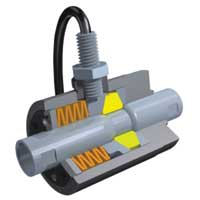
Posted to News on 14th Sep 2018, 00:00
Oil change offshore
Changing hydraulic and transmission oil in offshore wind power plants is a challenge. Speedwind Offshore has developed an innovative container-based system for rapid and clean oil changes at sea – currently the only one which has been certified by DNV GL. Axial overload elements provide shear protection in the device.

Wind, weather and waves make an oil change on offshore wind power systems a challenge, but regular changes of the hydraulic and transmission oils are nevertheless an important prerequisite to ensure a long service life for the systems, as wind power plants out at sea are exposed to immense stresses.
In addition, fluctuating temp-eratures and climatic conditions have an impact on the properties of the lubricants. With the container SWOC 1.0, Speedwind Offshore has developed an innovative system for rapid, safe and clean oil changes out on the open sea. The 20-foot container for extracting and filling the systems is transported to the wind farms by ship.
“The container does not require any equipment from the ship, only a space to deposit it is needed, says Uwe Thiele, project manager at Speedwind Offshore. “The container may be used on all ships operating in wind farms as it has been certified by DNV GL. That makes us the only company worldwide which can provide an oil change container with this certification.”
The container has two separate hose systems for unmixed filling of the transmission and hydraulic systems, and is designed for both daily and continuous use. It complies with the current occupational and environmental safety standards according to SOLAS (Safety of life at sea) and MARPOL (Convention for Prevention of Marine Pollution).
For example, a specially-developed shear protection device ensures that oil cannot leak during filling or pumping out, thus reliably preventing water contamination and environmental damage. In the shear protection device, the company relies on the tried and tested EAS-axial overload elements from Mayr Power Transmission. These overload elements are installed in the safety arm of the oil change container and disengage if the tensile or compressive force becomes too high, thus exceeding a pre-set value. The trigger force is set via the pre-tension force of thrust springs.
In case of overload, the bolt inside the EAS-axial force limiter shifts relative to the housing and moves the control segments radially outwards. The force transmission is immediately inte-rrupted.
“The shear protection is required if ships – even ships with Dynamic Positioning Systems (DPS) – are unable to maintain their position during the oil change, for example in case of rough seas, and drift away from the wind power system,” says Thiele. “If the pressure (or tensile force) becomes too high, the overload element in our safety system disengages and sends a signal to our PLC via an integrated limit switch.
“This triggers a so-called emergency and the oil pumps cease to operate. This all happens within a fraction of a second, and therefore an oil accident at sea is reliably prevented.”
The EAS-axial overload elements are manufactured from high-quality materials and have hardened functional parts, enabling them to achieve outstanding repeat accuracy. They are characterised by backlash-free force transmission with high axial rigidity.
10/11 Valley Road Business Park
Valley Road
BD21 4LZ
UNITED KINGDOM
+44 (0)1535 663900










